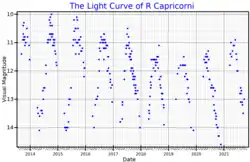R Capricorni
| Observation data Epoch J2000.0 Equinox J2000.0 (ICRS) | |
|---|---|
| Constellation | Capricornus |
| Right ascension | 20h 11m 18.35s[2] |
| Declination | −14° 16′ 03.4″[2] |
| Apparent magnitude (V) | 9.4 to 14.9[3] |
| Characteristics | |
| Spectral type | Cev[4] |
| Variable type | M[3] |
| Astrometry | |
| Proper motion (μ) | RA: +1.571[2] mas/yr Dec.: +1.420[2] mas/yr |
| Parallax (π) | 0.5515±0.0362 mas[2] |
| Distance | 5,900 ± 400 ly (1,800 ± 100 pc) |
| Other designations | |
| R Cap, BD−14 5663, GC 28001, SAO 163323, 2MASS J20111833−1416033[4] | |
| Database references | |
| SIMBAD | data |
R Capricorni (R Cap) is a star in the constellation of Capricornus.[4] It has an apparent visual magnitude which varies between 9.4 and 14.9.[3] A mira variable and ageing red giant, it is in the asymptotic giant branch stage of its lifespan.[5] It is a carbon star.[5]
John Russell Hind discovered this variable star in 1848. It appeared with its variable star designation, R Capricorni, in Annie Jump Cannon's 1907 work, Second Catalogue of Variable Stars.[6]
R Capricorni is too far from earth for its parallax to be measured effectively; Guandalini and Cristallo calculated the luminosity of Mira variables based on their periods. Using a period of 345.13 days, they calculated the absolute magnitude of R Capricorni to be -4.58.[5]
R Capricorni is losing mass at rate of 2.8×10−6 M☉/year.[7]
References
- ^ "Download Data". aavso.org. AAVSO. Retrieved 1 October 2021.
- ^ a b c d e Vallenari, A.; et al. (Gaia collaboration) (2023). "Gaia Data Release 3. Summary of the content and survey properties". Astronomy and Astrophysics. 674: A1. arXiv:2208.00211. Bibcode:2023A&A...674A...1G. doi:10.1051/0004-6361/202243940. S2CID 244398875. Gaia DR3 record for this source at VizieR.
- ^ a b c R Cap, database entry, The combined table of GCVS Vols I-III and NL 67-78 with improved coordinates, General Catalogue of Variable Stars Archived 2017-06-20 at the Wayback Machine, Sternberg Astronomical Institute, Moscow, Russia. Accessed on line November 9, 2009.
- ^ a b c "R Cap". SIMBAD. Centre de données astronomiques de Strasbourg. Retrieved 2025-08-12.
- ^ a b c Guandalini, R.; Cristallo, S. (2013). "Luminosities of carbon-rich asymptotic giant branch stars in the Milky Way". Astronomy & Astrophysics. 555: 7. arXiv:1305.4203. Bibcode:2013A&A...555A.120G. doi:10.1051/0004-6361/201321225. S2CID 54918450. A120.
- ^ Cannon, Annie J. (1907). "Second catalogue of variable stars". Annals of Harvard College Observatory. 55: 1–94. Bibcode:1907AnHar..55....1C. Retrieved 7 January 2025.
- ^ Uttenthaler, S.; McDonald, I.; Bernhard, K.; Cristallo, S.; Gobrecht, D. (2019), "Interplay between pulsation, mass loss, and third dredge-up: More about Miras with and without technetium", Astronomy & Astrophysics, 622: A120, arXiv:1812.07434, Bibcode:2019A&A...622A.120U, doi:10.1051/0004-6361/201833794, S2CID 119004841
